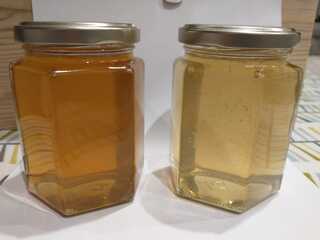- Joined
- Sep 4, 2011
- Messages
- 5,721
- Reaction score
- 5,326
- Location
- Wiveliscombe
- Hive Type
- National
- Number of Hives
- 24
Ok, so there are a few bubbles in the one on the right, but it had only been in the jar a couple of minutes...

The jar on the left is from the super immediately above the QX so perhaps more mid/late Spring and early Summer flowers. The jar on the right is from the super above it, perhaps more mid/late Summer flowers?
I'm pleased to have spotted this. Had I not had to extract one super early just to have some honey available for the local town show I'd probably just have extracted it all into the same bucket and never noticed.
James

The jar on the left is from the super immediately above the QX so perhaps more mid/late Spring and early Summer flowers. The jar on the right is from the super above it, perhaps more mid/late Summer flowers?
I'm pleased to have spotted this. Had I not had to extract one super early just to have some honey available for the local town show I'd probably just have extracted it all into the same bucket and never noticed.
James




